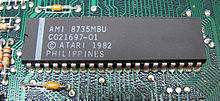This article has multiple issues. Please help improve it or discuss these issues on the talk page. (Learn how and when to remove these messages)
‹The template Manual is being considered for merging.›
|

Alphanumeric Television Interface Controller[1] (ANTIC) is an LSI ASIC dedicated to generating 2D computer graphics to be shown on a television screen or computer display.
Under the direction of Jay Miner, the chip was designed in 1977–1978 by Joe Decuir, Francois Michel, and Steve Smith[2] for the Atari 8-bit computers first released in 1979. The chip was patented by Atari, Inc. in 1981.[3] ANTIC is also used in the 1982 Atari 5200 video game console, which shares most of the same hardware as the 8-bit computers.
For every frame of video, ANTIC reads instructions to define the playfield, or background graphics, then delivers a data stream to the companion CTIA or GTIA chip which adds color and overlays sprites (referred to as "Player/Missile graphics" by Atari). Each ANTIC instruction corresponds to either blank scan lines or one of 14 graphics modes used for a horizontal band of the display. The height of each band depends on the mode. The instructions comprise a display list, in Atari parlance, which specifies how the entire display is built from a stack of individual modes.
The display list specifies where the data for each row comes from. For character modes, the base address of the character bitmaps is stored in an on-chip register and can be changed. Display list instructions can enable horizontal and vertical fine scrolling and mark that an interrupt should occur. An interrupt allows arbitrary 6502 code to execute, usually to change display-related settings in the middle of a frame.
Atari computer magazine Antic was named after the chip.[4]
- ^ Atari Home Computer Field Service Manual - 400/800 (PDF). Atari, Inc. pp. 1–8.
- ^ Neubauer, Doug (2009-06-20). "The Atari Years, by Doug Neubauer. Star Raiders, Solaris and Pokey". DougNeubauer.com.
- ^ US patent 4296476, Mayer, Steven T.; Miner, Jay G.; Neubauer, Douglas G.; Decuir, Joseph C., "Data processing system with programmable graphics generator", issued 1981-10-20, assigned to Atari, Inc.
- ^ Bisson, Gigi (May 1986). "Antic then and now. How the Atari community and this magazine grew up together". Antic. 5 (1): 16–17. ISSN 0745-2527. Retrieved 23 February 2023.